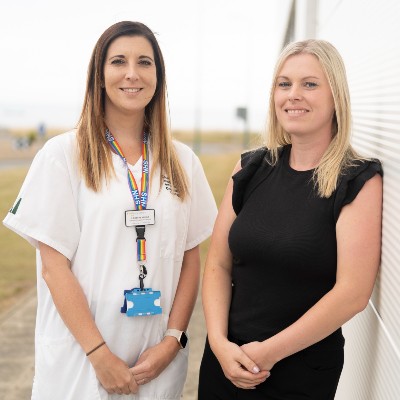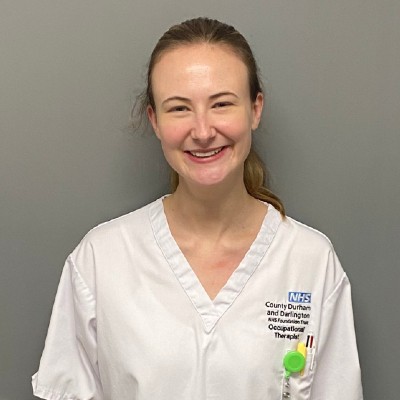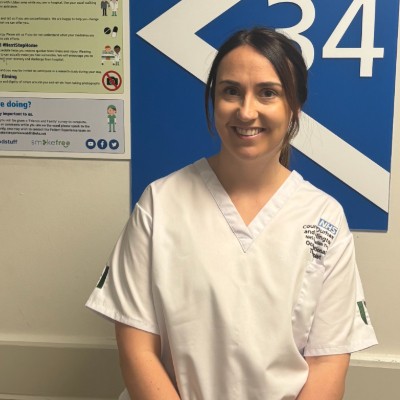Amy Fisk gives us a fascinating insight into her typical day as an Occupational Therapist working in adult social care.

Our assessments may involve giving advice or information, assisting in looking for more suitable housing, putting clients in touch with other services, or assist carers in maintaining their caring role. We may suggest a new way of carrying out certain tasks to make life easier or provide equipment or adaptations to help people do a task more independently or safely.
Alongside this ongoing case work we also supervise OT Assistants, facilitate student placements, attend internal and external training opportunities, and get involved with service development.
The day begins
It's Monday 8am and today my day begins with a commute to my dining room table. The kids have been dropped off at the childminder and I make myself a coffee while I log onto the computer.
Our team has been mobile working since before covid and we do a mix of home and office working, depending on the location of our daily visits or tasks. I log on to teams and say good morning to the team, we have an informal catch up and people discuss their plans for the day. I catch up with emails and messages from last week and I check my diary for the day and ensure I have the paperwork I need for my planned visits.
Before I go out, I have some admin tasks from last week’s visits to complete. The first is a referral to our handyperson service with a request for installation of minor works, a second stair rail and a grab rail, this is for a gentleman who is under care of the weight management service who is awaiting surgery for joint replacements, he needs something to assist at home for how is condition is presenting right now, but with a view to becoming more independent and mobile in the future.
The second is a referral to a local housing association with a recommendation for installation of a wet room. This is for a lady who has COPD and Emphysema and already has some adaptations to her property. She has been using equipment for some time but due to a decline in her, and her partners health this has become more difficult.
My first home visit is 10am. I meet a housing surveyor from our home improvement agency at the client’s property. I have already completed my initial assessment and determined the client’s needs, safer access to bathing facilities, where carers can support with tasks. This is a younger lady who suffered physical injuries in a car accident several years ago. The home visit is to determine the best option for adaptations via a Disabled Facilities Grant, to see if these are these feasible in her ensuite, or do we alter the family bathroom? Once we talk through the options and we look at what building work is feasible, we determine the least disruptive option and the client’s preference would be to alter the family bathroom. I will follow up this visit with an official referral to the team, and the grant process with begin.
An emotional visit
It's 11am and my next home visit is an initial assessment, I am visiting a gentleman with a recent diagnosis of Motor Neurone Disease. I meet the OT from the community neuro rehab team at the home address. The OT has already provided some equipment but has referred to our service to look at longer term plans and possible adaptations. As a community OT we do a lot of joint working with housing and health. Drawing on other services and their expertise to help make the client journey and experience the best it can be.
This is an emotional visit which lasts for almost two hours. All the family are present, and we are looking at planning for the next stages of the disease progression. We talk about suitable adaptations and timescales for getting these in place, we talk about possible difficulties he is going to experience and how we can reduce the risk around these. We agree that a referral to our social work colleagues is required to look at his care support needs, and we agreed to order some further equipment for trial while the family consider options we have discussed today.
After leaving the visit I grab some lunch on the road. An important skill of a community OT is knowing where you can stop for lunch and toilet facilities!
I have arrived at my third visit of the day - it’s 2pm and I meet the social worker at a local care home. This is to review an elderly gentleman whom we have been supporting in the community for several years. He has been placed in a care home following hospital discharge. He was admitted in a health crisis following a break down in his care package due to him refusing the carers to assist with personal care and transfers.
We have been looking at the long-term plans and assessing the feasibility and safety of him returning home or remaining in 24-hour care. He has settled well in his placement despite strong feelings about returning home when he first was placed. He is now allowing the carers to hoist him and looks well. We have determined what equipment and level of care is required if he returns home and we are now monitoring the case and will review the placement and his wishes in the coming weeks.
Juggling
I leave the visit and head to our equipment depot. I am picking up some equipment, for trial, for my final visit of the day. Usually, equipment is delivered by our provider to the home address, however this next client is a young lady with complex mental health needs, and she advised she would rather me bring the equipment with me on my visit. I am happy to do this to help gain her trust and build rapport. It’s 4pm and I arrive in the pouring rain, I am grateful they are not watching out the window as I try and get the wheeled commode out of the car, whilst juggling my notes and the puddles!
I take in the equipment and run through its functions and accessories. She has agreed to try this and feedback. We sit down to talk further, and I gather some more information to aid my ongoing assessment, following my visit last week the client is more comfortable talking to me and I am able to gain some valuable information to help determine her needs. I need to gather some further information from appropriate Health professionals, and we agreed to meet again in two weeks’ time.
It's 5pm - I head back home to my computer to start writing todays notes and assessments. Documentation is an important part of the job and a professional responsibility; I have set aside more time tomorrow to get admin work up to date.
Its time to log off for the day and pick up the kids from the childminder, hanging up the green fleece and putting on my ‘Mam’ hat. But ready to do it all again tomorrow!
As I walk around to collect the kids I reflect on the day. There is a lot of work and responsibility carrying a large caseload in the community, but I am grateful for a job that has such diversity, where I can see the positive impact I am making to people's lives.
Read about a typical day in the lives of other Occupational Therapists working in different roles for both Durham County Council and the NHS:




